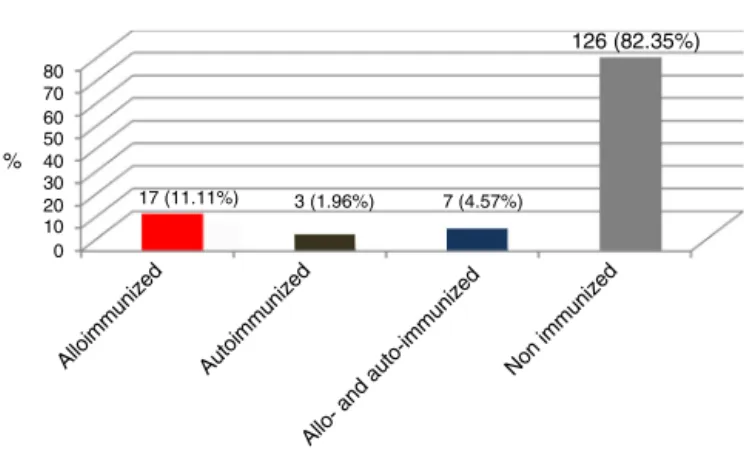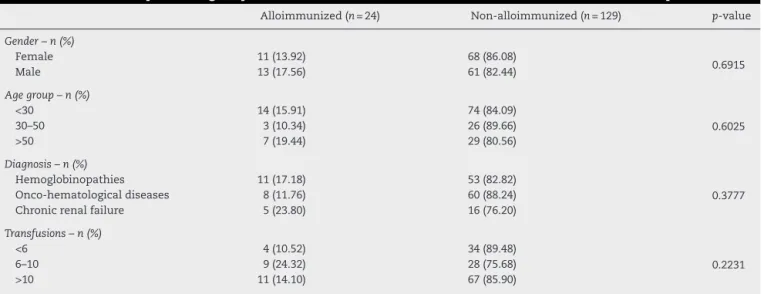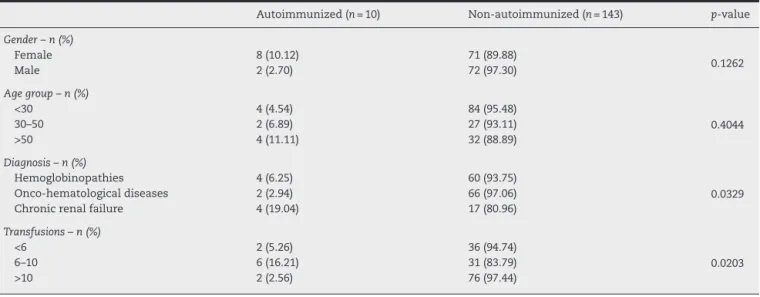w w w . r b h h . o r g
Hematology, Transfusion and Cell Therapy
Original article
Clinical and epidemiological profile of
alloimmunized and autoimmunized
multi-transfused patients against red blood cell
antigens in a blood center of Minas Gerais
Orsetti Gomes do Valle Neto
a,b, Vitor Mendonc¸a Alves
b, Gilberto de Araújo Pereira
b,
Helio Moraes-Souza
a,b, Paulo Roberto Juliano Martins
a,b,∗aHemocentro Regional de Uberaba, Fundac¸ão Hemominas, Uberaba, MG, Brazil bUniversidade Federal do Triângulo Mineiro (UFTM), Uberaba, MG, Brazil
a r t i c l e
i n f o
Article history:
Received 1 December 2016 Accepted 24 August 2017 Available online 17 February 2018
Keywords:
Multi-transfused patients Red blood cell antibodies Alloimmunization Autoimmunization
a b s t r a c t
Background:The large diversity of red blood cell antigens favors, especially in multi-transfused patients, the occurrence of autoimmunization and alloimmunization with the risk of hemolytic transfusion reactions. Thus, this study aimed to determine the rates of alloimmunization and autoimmunization in these individuals, as well as the types of alloantibodies and their systems, clinical and epidemiological aspects and the frequency of autoimmunity in alloimmunized and non-alloimmunized patients.
Methods:In a retrospective study, 153 multi-transfused patients from 2006 to 2014 were eval-uated. Sixty-eight had onco-hematological diseases, 64 had hemoglobinopathies and 21 had chronic renal failure. Descriptive analyses were carried out with the proportions being compared using the chi-square test, with the significance level set at 5%.
Results:The Rh system was the most frequently involved (53.11%) and anti-E and anti-K (Kell system) were the most prevalent alloantibodies (21.87% each). Autoantibodies were found in ten patients (6.54%) with the percentages of autoimmunization in alloimmunized and non-alloimmunized individuals being 29.16% and 2.32%, respectively (p= 0.0001). There was a significant difference between autoimmunization and the number of transfusions (16.21% in 6–10 vs. 5.26% <6 vs. 2.56% >10;p= 0.0203) and diseases (19.04% in chronic renal failure vs. 6.25% in hemoglobinopathies vs. 2.94% in onco-hematological diseases;p= 0.0329). Conclusion: The results show a strong correlation between alloimmunization and autoim-munization. Moreover, they reinforce the need for further studies on the clinical and epidemiological profile of multi-transfused patients in relation to alloimmunity and autoim-munity, especially the latter, for a better understanding of its etiopathogenesis and physiopathogenesis.
© 2018 Associac¸ ˜ao Brasileira de Hematologia, Hemoterapia e Terapia Celular. Published by Elsevier Editora Ltda. This is an open access article under the CC BY-NC-ND license (http://creativecommons.org/licenses/by-nc-nd/4.0/).
∗ Corresponding author at: Avenida Getúlio Guaritá, 250. Bairro Abadia, Uberaba, MG, CEP: 38025-440, Brazil. Tel.: +55 34 3074 3200.
E-mail address:paulo.martins@hemominas.mg.gov.br(P.R. Martins). https://doi.org/10.1016/j.htct.2017.08.001
Introduction
Red blood cell (RBC) transfusion is an essential resource
in the treatment of onco-hematological diseases,
hemoglobinopathies and chronic renal failure (CRF). As a consequence of multiple transfusions, RBC
alloimmuniza-tion is a common complicaalloimmuniza-tion among these patients.1,2
The antigenic difference between donor and recipient, the patient’s immune status and the immunogenicity of the RBC antigen are some of the factors that influence the formation of alloantibodies.3
More than 300 RBC antigens have already been discovered and organized in 36 systems, in particular ABO, Rh, Kell, Duffy,
Kidd and MNS.4This high number of antigens increases the
risk of RBC alloimmunization, making it difficult to obtain compatible RBCs, which can result in hemolytic transfusion reactions of variable severity including fatal in some cases.2
Patients with hemoglobinopathies present frequencies of
RBC alloimmunization of between 4% and 50%.5,6 In
individ-uals with onco-hematological diseases the percentage varies
from 9% to 13%7and in patients with CRF it is from 6.1% to
13.1%.8
RBC autoimmunization may occur in association with alloimmunization. Autoantibodies have been identified after
transfusions even without alloantibodies.9 However, there
are cases, such as in autoimmune hemolytic anemia (AIHA), that RBC autoimmunization can occur without any history of transfusions. Among the possible causes of this are the depression/modification of the immune system by viruses and drugs, alteration in the T cell balance and cross-reactions of antibodies induced by infectious agents with RBC surface
antigens.10The presence of RBC autoantibodies may interfere
in pre-transfusion blood compatibility tests between donor and recipient (cross-matching).11
Therefore, the aims of this study were to determine the percentages of RBC alloimmunization and autoimmunization in multi-transfused patients, as well as the types of alloanti-bodies and their systems, clinical and epidemiological aspects and frequency of RBC autoantibodies in alloimmunized and non-alloimmunized individuals.
Methods
This retrospective study evaluated 153 patients treated in the Hemocentro Regional de Uberaba (HRU)/Fundac¸ão Hemom-inas or Hospital de Clínicas da Universidade Federal do Triângulo Mineiro from 2006 to 2014, who had been trans-fused with at least three RBC bags on different occasions. Sixty-eight (44.44%) had onco-hematological diseases (acute leukemia, multiple myeloma, myelodysplastic syndrome), 64 (41.83%) had hemoglobinopathies (sickle cell anemia and tha-lassemia) and 21 (13.73%) had CRF.
Data were collected from patient files at the HRU focused on the production of alloantibodies (types and systems) and autoantibodies. The epidemiological and clinical profiles of alloimmunized and autoimmunized patients were character-ized according to gender, age group, diagnosis and number of transfusions before the identification of antibodies.
0 10 20 30 40 50 60 70 80
17 (11.11%)
Alloimmunize d
Autoimmunize d
Allo- and auto-immunized
Non immunized
3 (1.96%) 7 (4.57%)
126 (82.35%)
%
Figure 1 – Percentages of alloimmunized, autoimmunized, alloimmunized and autoimmunized, and non-immunized individuals against red blood cell antigens in 153
multi-transfused patients.
The results were stored in the Microsoft Excel program and organized into tables and graphs. The analysis was descriptive with proportions being compared by the chi-square test with the level of significance set at 5%.
The study was approved by the Research Ethics Committee of the Fundac¸ão Hemominas (#42047915.0.0000.5118).
Results
Of the 153 patients: 17 (11.11%) presented only alloimmuniza-tion, seven (4.57%) had RBC alloantibodies and autoantibodies and three (1.96%) had only autoantibodies (Figure 1).
Thirty-two alloantibodies were identified in 24 patients with six developing more than one. The most frequent were anti-E (Rh system) and anti-K (Kell system) (21.87% each), followed by C (12.50%) and non-specific anti-bodies (9.37%). Rh was the system most involved (53.11%) (Table 1).
Although not significant, the occurrence of alloimmuniza-tion was higher in men (17.56%), over 50-year olds (19.44%) and in those who received six to ten transfusions (24.32%). In rela-tion to diseases, alloimmunizarela-tion was more prevalent in CRF (23.80%), followed by individuals with hemoglobinopathies
(17.18%) and onco-hematological diseases (11.76% –
Table 2).
RBC autoantibodies were found in ten (6.53%) of the 153 individuals; in alloimmunized patients the occurrence was 29.16%, while in the non-alloimmunized group only 2.32% (p= 0.0001 –Table 3).
RBC autoantibodies were more common in women (10.12%), over 50-year olds (11.11%) and in those who received six to ten transfusions (16.21%;p= 0.0203). In relation to dis-eases, autoantibodies were more common in CRF (19.04%), followed by individuals with hemoglobinopathies (6.25%) and onco-hematological diseases (2.94%;p= 0.0329 –Table 4).
Discussion
Table 1 – Systems and types of red blood cell alloantibodies.
Rh n %
17 53.11
Anti-E 7 21.87
Anti-C 4 12.50
Anti-c 2 6.25
Anti-D 2 6.25
Anti-Cw 1 3.12
Anti-e 1 3.12
Kell – Anti-K 7 21.87
Non-specific 3 9.37
Lewis 2 6.25
Anti-Lea 1 3.12
Anti-Leb 1 3.12
MNS 2 6.25
Anti-M 1 3.12
Anti-S 1 3.12
Lutheran – Anti-Lua 1 3.12
Total 32* 100
∗ Total alloantibodies in 24 alloimmunized patients; six had more than one antibody.
by Alves et al.12who found, in the same service as this study, a rate of 10.49% in 143 patients in acute conditions, however the need was heterogeneous regarding the diagnosis and they mostly had simultaneous transfusions.
The most common antibodies were against the Rh (53.11%) and Kell (21.87%) systems similar to the literature which reports antibodies against the Rh system in 9.52–53.40% of cases and against the Kell system in 18.20–33.33%.6,8,13,14This may be explained by the fact that these systems are the most
immunogenic.15
The rate of alloimmunization was similar between genders. We must remember, however that women with chronic dis-eases generally have a lower parity index and, consequently, fetal-maternal alloimmunization than in the general
popu-lation, which might explain this result. Thompson et al.6
reported similar results (17.5% in women and 15.8% in men) when they evaluated 697 multi-transfused patients with thalassemia. Martins et al.16reported that 72.83% of all alloim-munized individuals are women; however, individuals in acute conditions were also evaluated.
Regarding the diagnosis, this study found that the alloim-munization rate was lower in onco-hematological diseases albeit without significance; this result is in agreement with the generally lower sensitization in these individuals due to the immunosuppression caused by the disease and its
chemother-apy and radiotherchemother-apy treatments.7Similar data are found in
the literature, with the percentage of alloimmunization
vary-ing from 9 to 13%7; in hemoglobinopathies, the frequencies
range from 18% to 47%.5
Considering the number of transfusions, although not sig-nificant, there was a higher rate of alloimmunization in those who received six to ten transfusions (24.32%), which corrobo-rates the findings of Martins et al.16that most alloantibodies are produced early (by the 10th transfusion). Even so, other studies have shown that sensitization was higher in patients who received more than ten transfusions12,17–19; it is believed that there is an individual predisposition, possibly of an inher-ited nature, which is present in the first exposures to foreign
antigens.20 In addition, Higgins and Sloan21 demonstrated
that alloimmunization is poorly correlated with the number of transfusions, with strong evidence of a subgroup of patients who present an increased risk of developing alloantibodies.
The percentage of RBC autoantibodies, in relation to diseases, was significantly higher in CRF however, the low number of these patients should be considered. The rates in individuals with onco-hematological diseases and hemoglobinopathies are in agreement with the literature; Sanz et al.14showed a lower rate in the first diagnosis, while
Thompson et al.6 found a higher frequency in the second.
We must reiterate that these findings are probably associ-ated with immunosuppression and/or treatments inherent to
onco-hematological diseases.7
Regarding the number of transfusions and RBC autoim-munization, this was significantly higher in those who received six to ten transfusions. We believe that, as in
Table 2 – Clinical and epidemiological profiles of alloimmunized and non-alloimmunized multi-transfused patients.
Alloimmunized (n= 24) Non-alloimmunized (n= 129) p-value
Gender – n (%)
Female 11 (13.92) 68 (86.08)
0.6915
Male 13 (17.56) 61 (82.44)
Age group – n (%)
<30 14 (15.91) 74 (84.09)
0.6025
30–50 3 (10.34) 26 (89.66)
>50 7 (19.44) 29 (80.56)
Diagnosis – n (%)
Hemoglobinopathies 11 (17.18) 53 (82.82)
0.3777
Onco-hematological diseases 8 (11.76) 60 (88.24)
Chronic renal failure 5 (23.80) 16 (76.20)
Transfusions – n (%)
<6 4 (10.52) 34 (89.48)
0.2231
6–10 9 (24.32) 28 (75.68)
Table 3 – Frequencies of red blood cell autoantibodies in alloimmunized and non-alloimmunized patients.
Total (n= 153) Alloimmunized (n= 24) Non-alloimmunized (n= 129) p-value
Autoantibodiesn– (%) 10 (6.53) 7 (29.16) 3 (2.32) 0.0001
Table 4 – Clinical and epidemiological profiles of autoimmunized and non-autoimmunized multi-transfused patients.
Autoimmunized (n= 10) Non-autoimmunized (n= 143) p-value
Gender – n (%)
Female 8 (10.12) 71 (89.88)
0.1262
Male 2 (2.70) 72 (97.30)
Age group – n (%)
<30 4 (4.54) 84 (95.48)
0.4044
30–50 2 (6.89) 27 (93.11)
>50 4 (11.11) 32 (88.89)
Diagnosis – n (%)
Hemoglobinopathies 4 (6.25) 60 (93.75)
0.0329
Onco-hematological diseases 2 (2.94) 66 (97.06)
Chronic renal failure 4 (19.04) 17 (80.96)
Transfusions – n (%)
<6 2 (5.26) 36 (94.74)
0.0203
6–10 6 (16.21) 31 (83.79)
>10 2 (2.56) 76 (97.44)
alloimmunization, these individuals are more likely to develop
autoantibodies. However, Thompson et al.,6 on evaluating
697 patients with thalassemia using a different methodology, did not find any significant increase in RBC autoantibodies in terms of the duration of hemotherapy until the fifth decade.
This study found that the frequency of RBC autoanti-bodies was significantly higher in alloimmunized compared to non-alloimmunized patients, which is in agreement
with Ahrens et al.22 These findings reinforce the evidence
that individuals who have already developed alloantibodies
produce more RBC autoantibodies.11 Ahrens et al.
sug-gest the hypothesis that this sensitization results from an overactive immune response, stimulated by epitopes of the antigen causing the response (intramolecular) associ-ated to other antigens (intermolecular). Such molecules, in large quantities, would contribute to the pathogenesis of chronic autoimmune diseases mediated by antibodies and T cells.22
As highlighted, the presence of RBC autoantibodies may interfere with pre-transfusion blood compatibility tests
between donor and recipient (cross-matching),11requiring an
exhaustive search of compatible RBCs and delaying the start of the transfusion.
Conclusion
In summary, this study reports high levels of alloimmu-nization and autoimmualloimmu-nization in multi-transfused patients. Further studies on the clinical and epidemiological profiles of these individuals are necessary for a better under-standing of the etiopathogenesis and physiopathogenesis of RBC alloimmunization and autoimmunization, espe-cially the latter, due to the scarcity of reports in the literature.
Conflicts of interest
The authors declare no conflicts of interest.
Acknowledgments
We would like to thank all the collaborators of the research, from the patients to the employees of the Hemocentro Regional de Uberaba (HRU)/Fundac¸ão Hemom-inas/Universidade Federal do Triângulo Mineiro (UFTM). To Amanda de Oliveira Santos, student of Biomedicina at UFTM, for supporting and assisting the study. To the Fundac¸ão Hemominas and Fundac¸ão de Amparo à Pesquisa do Estado de Minas Gerais (FAPEMIG) for the scientific initiation scholar-ship.
r e f e r e n c e s
1. McNerney ME, Baron BW, Volchenboum SL, Papari M, Keith M, Williams K, et al. Development of warm auto- and
allo-antibodies in a 3-year old boy with sickle cell
haemoglobinopathy following his first transfusion of a single unit of red blood cells. Blood Transfus. 2010;8(2):126–8. 2. Wang LY, Liang DC, Liu HC, Chang FC, Wang CL, Chan YS,
et al. Alloimmunization among patients with
transfusion-dependent thalassemia in Taiwan. Transfus Med. 2006;16(3):200–3.
3. Bilwani F, Kakepoto GN, Adil SN, Usman M, Hassan F, Khurshid M. Frequency of irregular red cell alloantibodies in patients with thalassemia major: a bicenter study. J Pak Med Assoc (JPMA). 2005;55(12):563–5.
5. Matteocci A, Pierelli L. Red blood cell alloimmunization in sickle cell disease and in thalassaemia: current status, future perspectives and potential role of molecular typing. Vox Sang. 2014;106(3):197–208.
6. Thompson AA, Cunningham MJ, Singer ST, Neufeld EJ, Vichinsky E, Yamashita R, et al. Red cell alloimmunization in a diverse population of transfused patients with
thalassaemia. Br J Haematol. 2011;153(1):121–8.
7. Schonewille H, de Vries RR, Brand A. Alloimmune response after additional red blood cell antigen challenge in immunized hemato oncology patients. Transfusion. 2009;49(3):453–7.
8. Babiker HA, Elsayed TY. Frequency of alloantibodies among chronic renal failure patients in Red Sea State. Indian J Hematol Blood Transfus. 2014;30(3):187–90.
9. Ahrens N, Pruss A, Kähne A, Kiesewetter H, Salama A. Coexistence of auto antibodies and alloantibodies to red blood cells due to blood transfusion. Transfusion. 2007;47(5):813–6.
10. Oliveira MC, Oliveira BM, Murao M, Vieira ZM, Gresta LT, Viana MB. Clinical course of autoimmune hemolytic anemia: an observational study. J Pediatr (Rio J). 2006;82(1):58–62. 11. Guirat-Dhouib N, Mezri M, Hmida H, Mellouli F, Kaabi H,
Ouderni M, et al. High frequency of autoimmunization among transfusion-dependent Tunisian thalassaemia patients. Transfus Apher Sci. 2011;45(2):199–202.
12. Alves VM, Martins PR, Soares S, Araújo G, Schmidt LC, Costa SS, et al. Alloimmunization screening after transfusion of red blood cells in a prospective study. Rev Bras Hematol Hemoter. 2012;34(3):206–11.
13. Obaid JM, Abo El-Nazar SY, Ghanem AM, El-Hadidi AS, Mersal BH. Red blood cells alloimmunization and autoimmunization among transfusion-dependent beta-thalassemia patients in Alexandria province, Egypt. Transfus Apher Sci.
2015;53(1):52–7.
14. Sanz C, Nomdedeu M, Belkaid M, Martinez I, Nomdedeu B, Pereira A. Red blood cell alloimmunization in transfused patients with myelodysplastic syndrome or chronic myelomonocytic leukemia. Transfusion. 2013;53(4): 710–5.
15. Bordin JO, Moreira Junior G. Sistemas Kell e Kx. In: STD: imunohematologia eritrocitária. Belo Horizonte IEA Editora/SBHH; 1996. p. 137–43.
16. Martins PR, Alves VM, Pereira GA, Moraes-Souza H.
Frequência de anticorpos irregulares em politransfundidos no Hemocentro Regional de Uberaba-MG, de 1997 a 2005. Rev Bras Hematol Hemoter. 2008;30(4):272–6.
17. Pinto PC, Braga JA, Santos AM. Risk factors for
alloimmunization in patients with sickle cell anemia. Rev Assoc Med Bras (1992). 2011;57(6):668–73.
18. Natukunda B, Schonewille H, van de Watering L, Brand A. Prevalence and specificities of red blood cell alloantibodies in transfused Ugandans with different diseases. Vox Sang. 2010;98(2):167–71.
19. Sakhalkar VS, Roberts K, Hawthorne LM, McCaskill DM, Veillon DM, Caldito GC, et al. Allosensitization in patients receiving multiple blood transfusions. Ann N Y Acad Sci. 2005;1054:495–9.
20. Novaretti MC. Investigac¸ão Laboratorial em Pacientes com Anticorpos Eritrocitários. In: Bordin JO, Langhi Júnior DM, Covas DT, editors. Hemoterapia: Fundamentos e Prática. São Paulo: Editora Atheneu; 2007. p. 186–9.
21. Higgins JM, Sloan SR. Stochastic modeling of human RBC alloimmunization: evidence for a distinct population of immunological responders. Blood. 2008;112(6): 2546–53.


